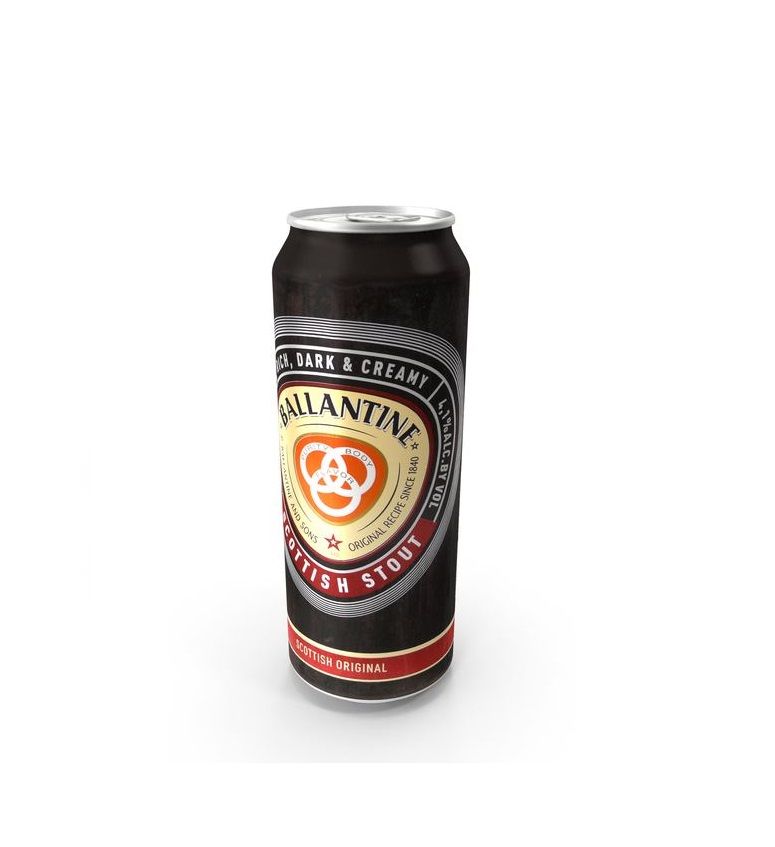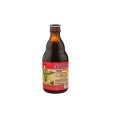P. Ballantine and Sons Brewing Company, established in 1840 in Newark, New Jersey, is one of the oldest and most influential breweries in the history of American brewing. Founded by Peter Ballantine, a Scottish immigrant, the company quickly rose to prominence, embodying the American entrepreneurial spirit and pioneering brewing innovations that would leave a lasting mark on the industry. Ballantine Beer, the company’s flagship brand, became synonymous with quality and tradition, celebrated across the United States for its distinctive taste and rich heritage.
By the mid-20th century, Ballantine Beer had become the third largest brewer in the country, renowned not only for its popular Ballantine XXX Ale but also for a variety of products that catered to an expanding American palate. The brand’s influence extended beyond the bottle, as it became a major cultural icon, sponsoring sports teams like the New York Yankees and engaging in advertising that became a benchmark for the industry.
However, the latter half of the century saw a shift in fortunes as the company changed hands multiple times. The original brewery was closed in 1972, following its acquisition by Falstaff Brewing Corporation. After several turbulent decades, which saw the brand nearly forgotten, Pabst Brewing Company acquired Ballantine in 1985. Under Pabst’s stewardship, there has been a concerted effort to revive Ballantine Beer’s legacy, particularly through the craft beer market. In 2014, Pabst relaunched the Ballantine IPA, aiming to recapture the original’s bold flavors and appeal to modern beer enthusiasts. Today, Pabst continues to produce Ballantine XXX Ale, striving to balance respect for the beer’s historical significance with the dynamics of contemporary brewing trends, thus keeping the venerable Ballantine name alive in the ever-evolving craft beer landscape.
| Aspect | Details |
|---|---|
| Founding and Early History | Established in 1840 in Newark, New Jersey by Peter Ballantine, a Scottish immigrant. Quickly rose to prominence in American brewing. |
| Mid-20th Century Success | Became the third largest brewer in the U.S., known for Ballantine XXX Ale and its cultural impact, including sponsorships like the New York Yankees. |
| Challenges and Changes | After changing hands multiple times, the original brewery closed in 1972. The brand struggled through turbulent decades under various ownerships. |
| Revival Efforts | Acquired by Pabst Brewing Company in 1985. In 2014, Pabst relaunched Ballantine IPA, aiming to recapture the original flavor and appeal to modern tastes. |
| Current Status | Pabst continues to produce Ballantine XXX Ale and other products, balancing historical significance with contemporary brewing trends. |
Contents
The Historical Journey
In 1840, Peter Ballantine, a Scottish immigrant, established the brewery that would become a cornerstone of American brewing history in Newark, New Jersey. Originally named Patterson & Ballantine Brewing Company, it began on a modest scale, renting an old brewing site that had been operational since 1805. Peter’s entrepreneurial spirit soon led him to buy out his partner and purchase land near the Passaic River, where he could expand his operations. By the mid-19th century, Ballantine’s sons had joined the business, leading to the company being renamed P. Ballantine and Sons in 1857.
The brewery’s innovative techniques and commitment to quality saw it grow rapidly, becoming the sixth largest brewery in the United States by 1879. This growth was fueled by the popularity of Ballantine’s flagship product, Ballantine XXX Ale, which set a high standard for American ales and became a beloved brand nationwide.

The 18th Amendment, enacted in 1920, initiated Prohibition, significantly impacting the alcohol industry in America. P. Ballantine and Sons, like many others, had to pivot quickly to survive. The company began producing malt syrup and other non-alcoholic products, a move that allowed it to maintain operations and preserve its workforce.
Leadership transitioned during this challenging period to George Griswold Frelinghuysen, the company’s vice-president who was married to a Ballantine granddaughter. Under Frelinghuysen’s leadership, the company managed to navigate through Prohibition, maintaining the Ballantine name and preparing for the eventual repeal of the 18th Amendment.
The repeal of Prohibition in 1933 marked a new era for Ballantine. The company was acquired by Carl and Otto Badenhausen, who were instrumental in revitalizing and expanding the brand. Under their guidance, Ballantine experienced its golden years, becoming the third-largest brewer in the U.S. during the 1940s and 1950s. This period was marked by significant innovations in advertising, including becoming the first television sponsor of the New York Yankees, a partnership that greatly boosted the brand’s visibility and popularity.
The post-war years saw a surge in Ballantine Beer’s popularity, driven by clever marketing campaigns and consistent quality. However, by the mid-1960s, the brand began to face intense competition from lighter lagers and changing consumer preferences, which signaled the start of a gradual decline.
| Year | Event | Impact |
|---|---|---|
| 1840 | Founding of Patterson & Ballantine Brewing Company by Peter Ballantine in Newark, New Jersey. | Initiates the legacy of what will become one of America’s cornerstone breweries. |
| 1857 | Name change to P. Ballantine and Sons after Peter’s sons join the business. | Reflects the family-driven nature of the business and sets the stage for future expansion. |
| 1879 | Becomes the sixth largest brewery in the U.S., driven by the popularity of Ballantine XXX Ale. | Establishes the brewery’s reputation for quality and innovation in American brewing. |
| 1920-1933 | Prohibition leads to pivoting to non-alcoholic products like malt syrup. | Helps sustain the company through the Prohibition era, preserving jobs and the company’s infrastructure. |
| 1933 | Repeal of Prohibition allows the return to brewing alcoholic beverages. | Marks a new era of growth and innovation for the company under new ownership. |
| 1940s-1950s | Ballantine becomes the third largest brewer in the U.S. and pioneers sports advertising with the New York Yankees. | The brand’s golden years, marked by widespread popularity and cultural impact. |
| 1960s | Beginnings of a gradual decline due to competition from lighter lagers and changing consumer preferences. | Signals shifting market dynamics and the onset of challenges for the brand. |
The Decline and Subsequent Ownerships
In 1972, the Ballantine family agreed to sell the company to the Falstaff Brewing Corporation. This acquisition marked the beginning of a challenging era for the brand. Falstaff struggled with financial issues and failed to maintain the quality and reputation of the Ballantine beers. During their stewardship, the original recipes began to be altered, and the brewing operations were moved from the original Newark location, further alienating longtime fans of the brand.

The decline under Falstaff’s ownership eventually led to the sale of the brand to Pabst Brewing Company in 1985. Pabst, recognizing the historical significance of Ballantine, made several attempts to revive the brand, particularly focusing on the craft beer market. In 2014, they relaunched the Ballantine IPA, an effort to recapture the original’s distinctive flavors and appeal to both old fans and new generations of beer enthusiasts. This relaunch was part of a broader strategy to reinstate Ballantine Beer as a premium brand within Pabst’s portfolio, aiming to honor its rich history while adapting to the modern brewing landscape.
| Year/Period | Event | Impact |
|---|---|---|
| 1972 | Sale of the company to Falstaff Brewing Corporation. | Marked the beginning of a challenging era; quality and brand reputation suffered under new management. |
| 1972-1985 | Falstaff’s management sees alterations to original recipes and relocation of brewing operations. | Contributed to the decline of the brand’s market position and alienation of its loyal customer base. |
| 1985 | Acquisition by Pabst Brewing Company. | Initiated efforts to revive the brand, focusing on its historical significance and potential in the craft beer market. |
| 2014 | Relaunch of Ballantine IPA. | Aimed to recapture the original flavor profile of Ballantine beers, appealing to both long-time fans and new beer enthusiasts. |
Ballantine’s Cultural and Commercial Impact
Over the decades, Ballantine Beer has produced an array of products that have significantly influenced American brewing. The flagship, Ballantine XXX Ale, is renowned for its robust and complex character, which set a high standard for American ales. This top-fermented ale has been a consistent favorite due to its unique blend of bitterness and aromatic hops. Another notable product, the Ballantine IPA, was an intensely bitter and aromatic brew, historically aged for a year in wood prior to bottling, reflecting traditional English IPAs.
The relaunch of Ballantine IPA in 2014 marked a significant moment in the brand’s history. This effort was not just about reviving a product but about reconnecting with a legacy of brewing distinctive and bold beers. The IPA was reintroduced with a recipe that aimed to mimic the original as closely as possible, based on extensive research and historical documents. This relaunch underscored Ballantine’s commitment to quality and tradition, while adapting to the modern palate, which favors complex and flavorful IPAs.

Ballantine Beer’s influence extends beyond the brewery and into American popular culture. It has been referenced in literature, music, and television, illustrating its integration into the fabric of American society. For instance, Hunter S. Thompson mentioned Ballantine Ale in his iconic novel Fear and Loathing in Las Vegas, highlighting its cultural relevance during the 1970s. Frank Sinatra and other celebrities were known to enjoy Ballantine, enhancing its status as a premium ale.
Ernest Hemingway also endorsed Ballantine Ale in a print advertisement, asking, “How would you put a glass of Ballantine Ale into words?” This campaign was part of a broader strategy that connected Ballantine with literary giants, thereby elevating the brand’s intellectual appeal. The inclusion of Ballantine in various forms of media underscores its role as a cultural icon, with a presence that resonates in the collective American memory.

Ballantine Beer has been a prominent sponsor of major American sports teams, including the New York Yankees and the Philadelphia Phillies. These sponsorships were not only a testament to the brand’s popularity but also a strategic move that placed Ballantine at the heart of American sports culture. The brand was one of the first to engage in television sports advertising, featuring prominently in game broadcasts and becoming synonymous with baseball.
The advertising campaigns, particularly in the mid-20th century, were groundbreaking. They utilized the latest media technologies and creative approaches that set the standard for beverage advertising. The memorable jingle “Baseball and Ballantine” became a staple during game broadcasts, linking the pleasure of a cold beer with the American pastime of baseball.
| Product | Description | Cultural and Historical Impact |
|---|---|---|
| Ballantine XXX Ale | A robust, top-fermented ale known for its unique blend of bitterness and aromatic hops. | Set a high standard for American ales and has been a consistent favorite, reflecting traditional brewing excellence. |
| Ballantine IPA | Historically aged for a year in wood, this intensely bitter and aromatic brew was relaunched in 2014 to mimic the original recipe. | Revival aimed at reconnecting with the brewery’s legacy of distinctive and bold beers, adapting to modern tastes favoring complex IPAs. |
| Cultural References | Referenced in literature and popular media, including by Hunter S. Thompson and in endorsements by celebrities like Frank Sinatra. | Integration into the fabric of American society, enhancing its status as a premium ale and a cultural icon. |
| Sponsorships | Prominent sponsor of American sports teams like the New York Yankees and the Philadelphia Phillies, and featured in game broadcasts. | Strategic sports marketing placed Ballantine at the heart of American sports culture, pioneering television sports advertising. |
| Advertising Innovations | Utilized the latest media technologies and creative approaches, including memorable jingles like “Baseball and Ballantine”. | Set the standard for beverage advertising, linking the brand closely with American leisure activities, particularly baseball. |
The historical importance and lasting legacy of P. Ballantine and Sons Brewing Company are undeniable. From its early days as a pioneer of American brewing to its role in cultural and commercial spheres, Ballantine has left an indelible mark on the industry and American culture. The brewery’s ability to innovate while maintaining a commitment to tradition has allowed it to endure through turbulent times, including Prohibition and ownership changes.
Reflecting on Ballantine’s impact, it is clear that the company was more than just a brewery; it was a cultural institution that mirrored and influenced societal trends and tastes. Whether through its innovative beers, its presence in popular culture, or its groundbreaking marketing strategies, Ballantine has played a pivotal role in shaping the American brewing landscape, proving that even as markets evolve, the demand for quality and authenticity remains constant.




